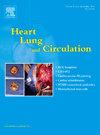Cardiovascular Risk Factors and Disparities in Management of Embolic Stroke: A Western Sydney Perspective
IF 2.2
4区 医学
Q2 CARDIAC & CARDIOVASCULAR SYSTEMS
引用次数: 0
Abstract
Background
Ischaemic stroke remains one of the leading causes of death and disability worldwide. The population of Western Sydney has a unique demographic with lower socioeconomic status and a culturally and linguistically diverse population. This study aims to investigate the demographics and cardiovascular risk factors of patients in Western Sydney, focusing on the prevalence and profile of cardioembolic (CE) strokes and embolic strokes of undetermined source (ESUS).
Method
Prospective data were collected in 463 patients with ischaemic stroke presenting to a tertiary centre in Western Sydney, who underwent predischarge transthoracic echocardiography. Patients with haemorrhagic strokes or unclear stroke diagnosis were excluded. Analysis of stroke subtype (CE, ESUS, or non-embolic) and clinical characteristics was performed based on age, gender, and prior atrial fibrillation (AF) prevalence.
Results
Of the 463 patients, 147 (32%) had CE strokes, and 147 (32%) had ESUS. Cardioembolic (CE) strokes were associated with older age (≥65 years) and a history of congestive cardiac failure. Older patients had higher rates of hypertension, ischaemic heart disease, AF, and congestive heart failure. History of AF was present in 67 patients (14.5%); however, only 51% received anticoagulation before admission despite a low bleeding risk. The transthoracic echocardiography characteristics of ESUS/non-embolic strokes differed from those of CE strokes; 20% of patients with ESUS had an enlarged left atrium, suggesting a subset of patients with ESUS with a left atrial myopathy.
Conclusions
Patients with ischaemic stroke in Western Sydney have a high prevalence of cardiovascular risk factors which were often undertreated. Half of the patients with prior AF did not receive anticoagulation despite low bleeding risk, indicating a gap in optimal stroke prevention. There were distinct echocardiographic characteristics among stroke subtypes. Further analysis of left atrium parameters may provide greater insights into the pathogenesis and prevention of embolic strokes.
心血管风险因素与栓塞性中风管理中的差异:西悉尼视角
背景:缺血性中风仍是导致全球死亡和残疾的主要原因之一。西悉尼的人口结构独特,社会经济地位较低,文化和语言多元化。本研究旨在调查西悉尼患者的人口统计学和心血管风险因素,重点关注心肌栓塞性脑卒中(CE)和来源不明的栓塞性脑卒中(ESUS)的发病率和概况:方法:在悉尼西部的一家三级医疗中心收集了 463 名缺血性脑卒中患者的前瞻性数据,这些患者在出院前均接受了经胸超声心动图检查。出血性中风或中风诊断不明确的患者被排除在外。根据年龄、性别和既往房颤(AF)患病率对中风亚型(CE、ESUS或非栓塞性)和临床特征进行了分析:在463名患者中,147人(32%)患有CE脑卒中,147人(32%)患有ESUS脑卒中。心肌栓塞性脑卒中与年龄较大(≥65 岁)和充血性心力衰竭病史有关。老年患者患高血压、缺血性心脏病、房颤和充血性心力衰竭的比例较高。67名患者(14.5%)有房颤病史;然而,尽管出血风险较低,但只有51%的患者在入院前接受了抗凝治疗。ESUS/非栓塞性脑卒中的经胸超声心动图特征与CE脑卒中不同;20%的ESUS患者左心房增大,这表明ESUS患者中有一部分患有左心房肌病:结论:西悉尼缺血性脑卒中患者的心血管风险因素发生率较高,且往往治疗不足。半数既往有房颤的患者尽管出血风险较低,但并未接受抗凝治疗,这表明在最佳卒中预防方面还存在差距。中风亚型的超声心动图特征各不相同。对左心房参数的进一步分析可能会为栓塞性中风的发病机制和预防提供更多信息。
本文章由计算机程序翻译,如有差异,请以英文原文为准。
求助全文
约1分钟内获得全文
求助全文
来源期刊

Heart, Lung and Circulation
CARDIAC & CARDIOVASCULAR SYSTEMS-
CiteScore
4.50
自引率
3.80%
发文量
912
审稿时长
11.9 weeks
期刊介绍:
Heart, Lung and Circulation publishes articles integrating clinical and research activities in the fields of basic cardiovascular science, clinical cardiology and cardiac surgery, with a focus on emerging issues in cardiovascular disease. The journal promotes multidisciplinary dialogue between cardiologists, cardiothoracic surgeons, cardio-pulmonary physicians and cardiovascular scientists.
 求助内容:
求助内容: 应助结果提醒方式:
应助结果提醒方式:


